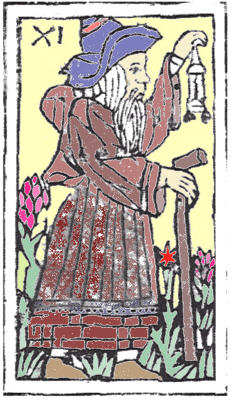PIRUCHO said:
Huck:
I could see that the Hermit of the Dick Sheet is holding a lantern instead of an hourglass (As Visconti pattern has it ),so closest to the TdM pattern.
http://trionfi.com/0/j/d/sheets/p/09.jpg
It is assumed that TdM pattern has its ancestor on the Cary Sheet (A Milanese pattern) even if there is not seen that card.
The Dick Sheet is a Ferrara pattern dated around 1500.
-Could be an historical link between the Dick Sheet and the TdM pattern ?
(Sorry for my poor english )
PIRUCHO said:
Also there are two another Ferrara pattern examples about this:
Alessandro Sforza ( 1470 ) and Charles VI (1475)
In both cases the Hermit is holding a lantern.
So how can I understand the Milanese ancestor of TdM where the pattern is the hourglass ?
Having in mind that all of them along with the Cary Sheet are closer in terms of time (Fifteenth century )
Hi Pirucho,
the time between 1500 (an assumed date for the Cary-Sheet) and 1650 (assumed start of the Marseille pattern) are ca. 150 years (a long time) and unluckily we have not very much examples of Taraux or Tarocchi decks from this period ... so there is not much hope to generate a somehow plausible speculation about the movement of Tarocchi motifs.
Is this "c. 1500" for the Cary Sheet really a reliable dating? What is it based on?
Maybe I've heard once an explantion, but I don't remember. Paper analysis? What's the argumentation?
Generally we have a stronger political closeness between French and Italian development in 1500 - 1527 till the battle of Pavia and later we have two Italian (Medici) Queens on the French throne (naturally connected to some exchange of cultural details between the both regions).
The dating "c. 1500" for the Cary sheet might go back to the consideration, that 1500 - 1527 was a time of close French-Italian relations ... so it would be a plausible suggestion, but by no means reliable fact, ....only a plausible suggestion, just considering this one argument.
But: Contradicting the similarity between Cary sheet and Marseille deck would suggest, that the Cary Sheet might be of a younger date than 1500. With no word about paper analysis or any other convincing argument the whole matter might present just one of the many open questions in playing card rersearch.
The hermit in the Charles VI and the Alessandro Sforza deck shows an hourglass, no doubt, not a lantern. So it's Father Time.
(btw... the origin of the Charles VI deck was debated here at Aeclectic at the begin of this year and the obverall opinion seems to have changed, that it is not a Ferrarese deck, but from Florence. Individual suggestions about the correct date noted c. 1450 and myself estimated ca. 1463.)
The object of the hermit of the Dick Tarot is not obvious, to the innocent eye it seems more a lantern than an hour-glass. But the presented person has a hunch-back as much other contemporary pictures, so again: it's Father Time.
In the colored (not original, Trionfi.com made) version of the woodcut the hunch-back is better recognizable.
The hermit of Rosenwald sheet (Italy) is a cripple with two sticks, so obvious Father time again. (Kaplan I, p. 130) Neither the hour-glass or a lantern is used. Similar another early sheet with 6 cards of the Bolognese pattern and other Bolognese patterns from later centuries repeat or modify this theme, all reaching in their icongraphy far back to the style, in which the mid 15th century Petrarca motifs were painted.
The first still extant "clear" lantern might be at the hermit card of Catelin Geofrey 1557, connected to a rosary with a cross (Lyon, France - Kaplan I, p. 132). Another rosary seems to be at the Parisian Tarot (France - Kaplan I, p. 135), again the person has a lantern.
The Marseille Tarot reduces the rosary, but it's a lantern now and the whole is called "l'Ermite".
The Italian term is gobbo (hunch-back), the French card titles present expressions, which English language identifies as hermit.
It seems remarkable, that French and other North Europeans artists painted more than once a scene, in which the philosoph Diogenes watched with his lantern (at daylight) for a true man on the market of Athen (without success).
France 1553, from Guillaume Le Perrerière: Morosophie
http://www.emblems.arts.gla.ac.uk/french/emblem.php?id=FLPb031



